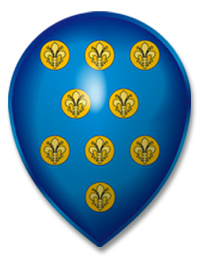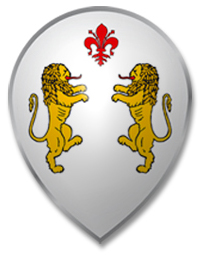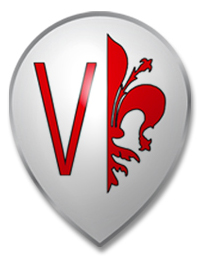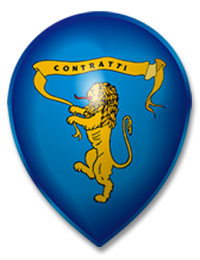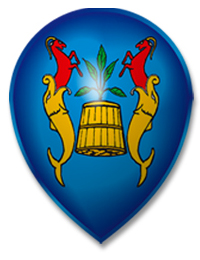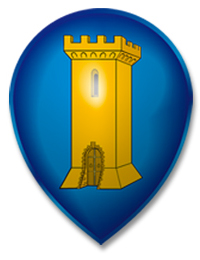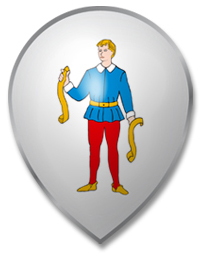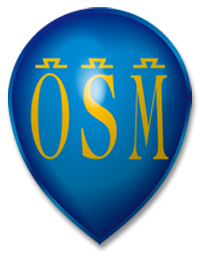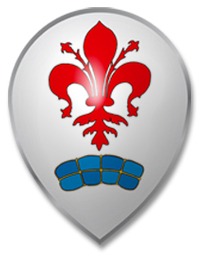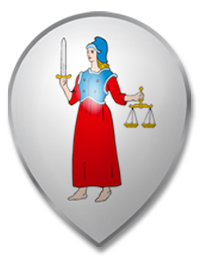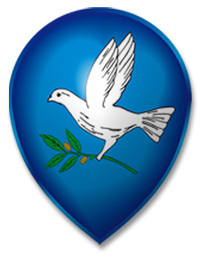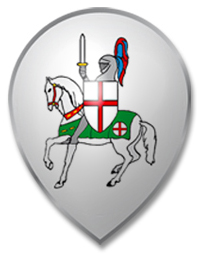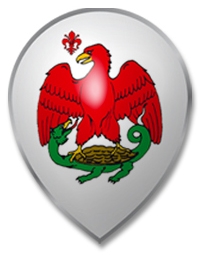The Magistracies or Uffizi (offices) were the Public Authorities of the Republic of Florence.
Each Magistracy identified the sector to rule.
Masters of the Coin Institute
This Magistracy was established in the thirteenth century and two Officials were called to preside over it. They were previously nominated “Signori della Moneta” (Lords of the Coin) and then “Signori o Maestri della Zecca”(Lords or Masters of the Coin Institute), which the first one was elected every six months by the Wool Merchants Guild of Calimala, whereas the other one by the Money-changers Guild. To them it was given the cautious supervisory task on the coinage, manufacturing coins and engraving on them their own signs or arms. In addition to that, they also decided the price of the foreigner coins with authority… they allowed or prohibited their circulation and they had the permission to find and punish the forgers. Moreover, the half-yearly election of the Notary and of all the others minor Officials depended upon them. On 6th December 1324 a reform was made in order that the Florentine coins could maintain their prestige; by that reform it was established the ”Checking Office”, joined to the Coin Institute and headed by a “Checking Master” or “Head Checker”(one who verified the real value of the coins), supported by eight citizens with tasks of weighters, head checkers and “rimettitori”(those who brought back by additions the coins to their real value). These new Officials had to “check” the coins – weight and seal them and register their characteristics: number, total weight of the metal and the coin’s manufacture quality. The coins which were identified of being badly manufactured, had to be cut and could not be used anymore. The Masters of the Coin Institute used not to have precise sessions, but they met up together at each election of the Magistracy; when he “piglia l’Ofitio” (takes the task), therefore without having prearranged working days. The assemblies took place in their living place located right in Piazzale degli Uffizi, next to the Loggia della Signoria; on the lintel of the front door there are still now sculpted the coats of arms of the Republic, of Wool Merchants Guild of Calimala and of the Money-changers Guild. During the construction of the Loggia, the Coin Institute was moved to Florence river bank “Lungarno” that still bears this name, but as work completed it was again brought back to the Uffizi. The Magistracy of the Coin Institute had the emblem on a light blue background covered with roundels of gold florins (old Italian coins).
Magistracy of the Honesty
This Magistracy was established in 1415 and ruled by eight elected citizens called Officials of the Honesty, who had the important and delicate function to keep that virtue in the public. They protected morality and decency; for the performance of their duties the predicted eight of Honesty were authorized to go at night time with lamp and without it. The Officials were careful that women of easy virtue observed the rules of the statutes related to them; they held continuosly updated the lists of the prostitutes from which they collected the established fee for the world’s oldest profession; also they judged the causes between harlots and citizens. In addition to the payment of the prescribed tax, the prostitutes had to wear a particolar sign on the clothes consisting of a yellow bow, otherwise they could not carry out their activity. However, gradually the use of that sign disappeared and was replaced by a payment of another tax.
To leave the house at night time, the “ladies of the night” had to be in possession of a written note, a special licence issued by the Officials of the Honesty… after the occurred collection of the tax. The law established severe penalties for the harlots ended up into the offences of blasphemy, theft or excessive ugliness. Depending on the seriousness of the case, the sentences ranged from the forced bath in Arno, tied up and lowered by a bridge, chaining to the pillory loca
ted in front of the “Magistracy’s Office”. The Officials made their sessions on Tuesdays and Fridays, morning and evening, in their residence located in the Piazzetta dei Tre Re, still now existing with this name, in which we can enter from via Calzaiuoli, precisely through an alley called “ Vicolo dell’Onestà”. The emblem on a white background showed two gold rampant lions facing each others, with a small red lily between their heads.
Office of the Tithes
The Florentine Tithe was a tax or a tribute of 10 per cent which burdened the income of the properties. It was established in 1469 and subsequently reformed in 1494 in charge of all citizens living in Florence and in the County, who had to pay for it to the Council every year. The Magistracy who supervised the Tithe collection was composed of four citizens, experienced to offices and not less than 35 years old; throughout the whole city they had to be called Officials of the Tithe. At first this tax was added to the Land Registry; the office to which each citizen had the obligation to register his own properties. Afterwards the Tithe took over to the Land Registry itself when the law of 1494 decreed that it was ordinary and perpetual and to be revised every triennium and imposed every year with the abolition of the deduction entries.
The Tithe which was previously applied in the city, in 1504 was also extended to the County and then to the whole Florentine Dominion, but by varying in the percentage. Then, in situations of necessity it became deducted as the current progressive tax. Whereas, the citizens who did not declare their own assets or did it partially, they would have been taken away from their possessions not been declared. The Officials of the Tithe used to join together on Wednesdays and Thursdays evenings and their registrations were made on appropriate books. This Magistracy’s emblem was displayed on a white background with a red lily halved vertically to the right; whereas on the left side there was placed the letter “V” of the same colour.
Masters of the Gabelle of Contracts
The gabelle of contracts was a tax or better saying an indirect tax calculated according to a percentage and applied on any contracts, agreements or deals – between two or more people or parts, with the purpose to form a legal patrimonial relationship appropriately registered; partly such as the Public Registry Office of nowadays. The simple word “Contracts” was used to indicate this magistracy. The Magistracy was established around 1316 and were arranged Officials denominated Masters of the Gabelle of Contracts or Superintendents of the Gabelle of Contracts or even Superintendents of Contracts. These Officials had to look after the regulation, the application and the council tax collection, which precisely burdened the public writings, that on hands of their notary, had to be notified, wrote and registered on the books for notifications of the Gabelle – so as to produce all the legal terms. The Officials had jurisdiction and authority to judge the civil and penal causes regarding the gabelle and then seriously punish the submitted, who refused the obligation of payment. According to and depending on the law, the punishments given to the violation provided by law, got even to cut off the head – a punishment certainly discouraging for any potential tax evader! Dino Compagni, in its La Cronica lets us know that the gabelle of contracts gave to the Council a return of twenty thousands of gold florins every year. On 26th March 1528 a law was approved for every notary pledging them to keep their own protocols in sealed books rather than loose. Also, they were bound to translate each of their instrument in Vulgar language; thus, copied in four books – one for each neighborhood – duly appointed.
The Masters of the Gabelle of Contracts used to meet up in their sessions every Tuesday morning and Wednesday evening. This Magistracy had as an emblem on a light blue background a rampant gold lion with the red tongue, turned towards left. It grasped upward a cartouche with the inscription “Contracts”.
Officials of the Grascia
“Grascia” or better saying something or anything which people needed, was also the name of a Magistracy, which in particular, had the task to check or supervise the right price of the “grascie” which were sold at retail. To establish this Magistracy, five Officials were elected in order to provide the citizens with good reason, which among their many important duties, they supervised the supplies of all the different types of food products. Additionally, they had to decide the selling prices to the public and also had to keep an eye and make sure that the prices were correctly applied to avoid any illegal speculations from the sellers. Moreover, the Officials of the Grascia, also had to pay attention on the genuineness of the products, on the right amount of weight and measures and on the mills and millers. In addition to their tasks, they also had to decide the wage of the labourers working for that service, forcing the communities to keep the best maintenance of the streets and bridges, to make sure that there was an excellent transport for the victuals to and throughout the city. Their jurisdiction was also extended to the lakes, where they rented the fishery, forcing fishermen, as they were tenants, to bring the catch directly to the city (so that they could not sell it illegally throughout the streets), in the usual public places, on the cutter plates in Piazza del Pesce or in Mercato Vecchio – where the products were exposed and put on big inclined slabs.
To protect the public health there was a rule, which forced bakers to put and keep a stick or a straw inside their baskets where bread was kept. So that customers could point to the bakers the shaped bread they wished to buy, instead of touching it with their hands. It was a market hygiene standard of a singular caution, which denoted the progressed unusual mentality elsewhere back in the days. Strict punishments were set up and given to the sellers, who would have turned a blind eye breaking and going against the law. The assemblies of the Officials of the Grascia used to take place on Tuesdays morning and evening, Fridays evening and on all the Lent’s Fridays morning and evening as well. The emblem of this Magistracy showed in a light blue background two dolphins facing a “moggio” (bushel) of the same colour, from which 5 ears of wheat can be seen sticking out. Whereas, from the mouths of the two dolphins protrude two half red male sheeps.
Masters of Salt
With this name were designated the Officials who managed the “gabella del sale”, also known as the imposition of the salt or salt tax. This fee, which today we would call a direct tax, consisted in imposing citizens who had to pay for it, called “Bocche di sale” (Mouths of Salt) or “Bocche salate” (Salty mouths) to take and pay to the government – based on the number of family members and their substances – the amount of salt at the price that the Officials established at their discretion. Salt is widespread in nature, in the seawater and as a mineral; apart from being used widely in diet (and for this reason the sale of it was imposed to all citizens), it was also put to preserve particular foods, and in the handmade tannery and dyeing industry. However, salt was and still is, the most common seasoning in cookery. Nobody can stay without it, but obviously when it is used with the right amount.
An old Tuscan proverb, in this regard, mentions that “Salt adorns recipes and spoils them as well!” The Official Masters of Salt, had the authority to fine those who had tried to avoid payment owed to the city institution by applying a surcharge of a one quarter and even sometimes reaching to deny its essential distribution. The compulsory “Boccatico” of the salt – a personal tax which is multiplied by the number of individuals (mouths or heads) – originated by the fact to be able to scarcely deny and contrast its smuggling. It was said that the Salt Wage was the amount of this element corresponding to the weight of 170,640 pounds, and the price or money corrisponding to that amount. Since 1320 it was also given to the Masters of Salt the management of slaughterhouses and the places of wine storage. The Officials used to join up together every Tuesdays and Fridays evenings. Their emblem showed a covered red cup on a white background.
Masters of Customs
Customs was the tax area where the merchandise subject to duty was checked at the time of its entry or exit from the state, which mostly took place directly at the city gates opened along the defensive walls. Customs was also known as the words “gabella” or “balzello”, which this is the tax that was payable on goods, as indeed in some ways it is nowadays. “Gabellotto” (precisely from the word “gabella”) was popularly known as an ancient Florentine silver coin, which its real name though was barrel. It was coined for the first time in 1505 and it had the value of money 12 and 6 denier. It took the name of “barile” (barrel), because a piece exactly corresponded to the gabelle on a barrel of wine, amounting to twenty flasks. The name “Dogana” (Customs) dates back to the Arabic word DIW… that is the Office of Finance Administration. At the beginning from here the name “Dovana” came from and then, for correction, “Dogana”.
The Masters of Customs who had the chores to provide that the Council was not deceived (defrauding the Treasury – it’s always been a trend!) were the officials in charge of the collection of those taxes. Their meetings took place on Tuesdays mornings and Fridays evenings. In case of a coincidence with a public holiday or a special occasion, the meetings were postponed to the following day. The old Customs Office, which is still called the Customs door, was located on the side of Palazzo Vecchio (side Via de’ Gondi), where on the area of the gateway, it can be seen the tower crest of those Masters. Furthermore, this Office had an emblem on a light blue background, where a squared gold tower with Guelph merlons was represented on it.
Office of the Orphans
This Magistracy was made up of four good, honest and merciful Officials men, who had to care of all the orphans been left under their control until they have reached the right age. The orphans were minors (under 14 years old if males, 12 if females) who have been orphaned by their fathers. The Officials looked after the assets and the children’s relatives and widows (unless parents and husbands did not leave any particular tutors), who found them as a very valid defenders of their fair rights. Under the protection of this Magistracy there were also the deaf-mutes and the imbeciles. The Officials of the Orphans and Widows, had to be at least forty years old; be conjugated and with children, so they could better realise the relatives’ needs, in defense of which they had the authority..judging all civil and criminal causes that harmed them.
However they could not re-marry with any of the orphan women; including mothers and sisters of the children, and not even buying anything from them. So, their protection on alone and undefended people was effective immediately; the law forced the gravediggers to notify, within three days, all people who nearly dying had left the orphans and widows, in order to be able to provide effectively as rapidly as possible, to their needs. By a regulation made in 1767 the task of being universal tutors was removed from these Officials. The assemblies of these Officials used to take place on Tuesdays, Wednesdays and Fridays morning and evening, in their residence located in Piazza del Duomo, which later become the place of the Mercy Archconfraternity, where the hall’s Magistracy is currently the chapel. Their emblem made in a man figure wearing red tights and light blue jacket with cuffs and white collar; the right arm of the young man is square shaped whereas the left one was hanging along the side; in the hands of the young there is a broken cartouche, all over on a white background.
Captains of Orsanmichele
On 10th August 1291, the laical Confraternity of “Santa Maria di San Michele in Orto” was established, to honour the Madonna (Virgin Mary) with chants or songs which every night the devotees used to raise to the miraculous image of the God’s Mother. It was located under the lodge of Orsanmichele, where in the morning also took place the market of grain and fodder.
This image of the Madonna, painted on a pillar by Ugolino da Siena was object of a great veneration and it was even named “Madonna delle Grazie” (Virgin Mary of the Graces). This was because of the many miracles that continuously were ascribed to Her. It was among many devotees who met up together every evening in front of the sacred image to sing the praises that this Confraternity was made up, also called of the “Laudesi” because of the praises that they sang. The Confraternity was administered by six Officials denominated Captains of Orsanmichele – who were also heads of it – and it was even called of the “Beata Vergine pura Madonna di San Michele in Orto” (Blessed Virgin pure Mary of San Michele in Orto).
The good and honest Captains and of good conversations, gave the money offers left by devotees to charities by aiding the poors, helping the religious people and subsidising hospitals – as well, of course, to rule their Confraternity. During the terrible pestilence of 1348, the Captains of Orsanmichele received numerous assets for bequests from many citizens, who had for them a great confidence and esteem. In fact, the Captains were chosen among the citizens of proven honesty, faithful and devoted of the Holy Roman Church and notoriously guelphs. The conspicuous wealth of the assets suffered a significant decrease during the siege of Florence in 1530; when the institution was forced to discard them to make a financial contribution to the defense of the homeland. The Captains joined together every Thursday evening, on a non-public holiday day, otherwise the hearing was postponed to the following evening. The assemblies took place in their house located next to Orsanmichele, on the corner of Via Calzaiuoli and Via dei Lamberti, in the palace that still shows the coats of arms in stone. It had as an emblem the three gold initials “OSM” on a light blue background.
Court of Merchandise
Around the XIV century, the Guilds created this legal institution which was above them with the function to resolve the controversies arisen within Corporations in order to analyse and rule commercial disputes amongst merchants at an international level as it had to protect the Council’s interests for trade-related reasons which could eventually bring about disagreements with other states.
The authority and the prestige of this Court was so huge that its unappealable sentences were respected abroad, too. The Court of Merchandise was composed by a foreign law officer, supported by councilmen citizens, who in the past were five and then six, called precisely, the Six of the Merchandise. Five of them became from the Greater Guilds (Merchants, Money-change, Wool, Silk, Physicians and Pharmacists) whereas the sixth one was selected by lot between the 14 Lesser Guilds and the Furries and Skinners Guild! Since 1355 the sentences and the acts of the Court were appointed in Vulgar language rather than Latin. In 1358 gave birth the construction of the magnificent residence of this Magistracy, in piazza della Signoria on the corner of via de’ Gondi. On the facade the twentyone coats of arms of the Guilds still stand out, sculpted in stone and positioned in a horizontal line. The Court of Merchandise made his sessions every day, in the morning and evening, whereas on Saturdays they took place only in the morning. This Magistracy chose, not by chance, Saint Thomas the Apostle, as saint protector whose statue, together with the one of Jesus that shows to the doubting Thomas the lesion of ribs, was placed in 1486 outside Orsanmichele by Andrea del Verrocchio. The judges of the Court, just as their saint protector, had to be always incredulous before clarifying the facts and judging after the aftermath that occurred! The emblem of this Magistracy showed a Florentine red lily on top of a light blue tied bale on a white background.
Conservators of Law
A provision on 10th February 1428 approved by the “Signoria” (Lordship) established this magistracy, whose function was to protect the State’s safety and justice by the check of regular and legitimate election of the Florentine and foreigner Officials. They were going to hold an office, if they enforced the ordinances and the Republic’s laws, and if they paid attention on the observance of their obligations proceeding against the possible transgressors, civilly and criminally. Therefore, they criticised on all Republic’s Magistracies. This Magistracy was composed of ten citizens, older than 35 years: chosen and remunerated among those who were enrolled at “Greater and Lesser Guilds”. They could not refuse the role unless for particular greater reasons, validated by the Lordship, to justify the resignation from the office that lasted six months.
This Magistracy still had jurisdiction for criminal blasphemies, sodomy and games causes. It also monitored that the unable citizens who were admonished or blamed, did not exert the Magistracies or the Uffizi (offices). In 1532 it was entrusted with the concerns of the poor too. Anyone who felt excessively oppressed could appeal to the Conservators of Law. An edict on 30th December 1771 reduced to only three Conservators the components of this Magistracy. The Conservators of Law used to join up together on Tuesdays, Wednesdays, Thursdays and Fridays, morning and evening, of each week, and lasted until 30th June 1777, when this Magistracy was definitively abolished. It had as an emblem a woman figure who represented the Justice, barefooted, wearing a red skirt and a light blue corset; the raised right arm grasped a light blue sword while from the left hand it dangled a scale; the background was white.
Magistracy of the Five Conservators of County and Dominion of Florence
It was established on 18th January 1419 and was composed of five citizens who had the authority… to moderate, monitor and check on the expenses (up to the abolition of those unnecessary) of the administrative offices of all the Councils which were part of the Florentine Dominion. The five Conservators made their sessions the morning of Thursdays, Fridays and Saturdays in their residence located in Chiasso Baroncelli. The name of this narrow street that from Piazza della Signoria, next to the Loggia dei Lanzi, leads to via Lambertesca came from the Baroncelli family, which had their houses. The family, who gave to the Republic 9 Gonfalonieri (standard bearers) and 40 Priors, has moved to Florence from Poggio di Baroncelli above Bagno a Ripoli.
On 4th November 1551 implemented certain reforms which assigned the Magistracy the authority and jurisdiction on all places of the District, County and Florentine Dominion, so without their license they could not fund, pay universal and extraordinary expenses; they presided over the appraisal of the County and District, monitored the deposits, money and insurances for the good administration. Also without their specific licence it was not possible to build or repair walls, mills, streets, bridges and other similar expenses in walled places. Against possible transgressors the Five Conservators set up legal action and pronounced the sentences. All above were the duties and authority that competed to this magistracy, abolished on 26th February 1559. Therefore its functions were delegated to the Nine Conservators of the Florentine Dominion by newly institution. The Five Conservators had as an enblem, on a light blue background, a white dove towards left laid on a green olive branch.
Office of the Eight of “Guardia e Balia”
In order to guarantee in the best way possible the calmness and safety of the city and the county inhabitants, in 1375 was established the Magistracy of the Eight of “Guardia e Balia”, to which were assigned police duties. It has been said “of the Eight” because it was composed of such number of Officials, elected two at a neighborhood; it had the name of “Guardia” because‚ it protected the freedom, the order and the decent living in all the city area and the Florentine Dominion (as demonstrated by the several tender notices now still existing on stone plaques in many streets of the city); the name “Balia” derivated from the authority to search for and capture the transgressors, the rebels and the common criminals. Also to submit them to the tortures and convict them to any punishment by legal actions from the same court “of the Eight”, whose sentences were unappealable.
Generally the authority of “Balia” was renewed bimonthly by the Signoria, that is every taking office of it. However it had the right to deny it if reasons of public needs had advised or imposed it. In this case the “Signori Otto”, exclusively of “Guardia”, had the only duty to imprison the fugitives which were then judged and convicted not from them, but by the Signoria. Therefore, in this role they had to be careful to those who did things against the army, the city and the Council’s Castles or Lands. They are not allowed to punish, but to put the guilty in the hands of the Chancellor, who does justice. The duties of these Officials had a duration that over the time varied from one year to six or four months; they used to meet up together every day, in the morning and evening, except on Saturdays evenings, in the Palazzo del Podestà, or Bargello, where the legal actions and the sentences took place. The emblem of the “Signori Otto” showed in a white background a soldier on horseback headed left, carrying a drawn sword in the right hand whereas in the left one a white pavise with the People red cross; a green caparison also with the red cross in the ending part, covered the horse. All the other colours are natural.
Office of the Common Bank (or “Monte delle Graticole”)
In 1343 was created in Fiorenza the Office of Common Bank, and for each Neighborhood was set up a book in which were been reported all the sums of money that the private citizens lent to the Council, receiving of course an annual interest. The word “monte” was used, in this case, as economical term to indicate the operation which conveyed a money stream. Benedetto Varchi writes that the Republic, which had accepted big sums of money, approved that each person had in its favour the 25 per cent. The prospect of a good investment encouraged many parents, in occasion of a daughter’s birth, to deposit a certain sum of money to the Common Bank, that remained bound for a specific number of years, in order to provide to the daughter a safe dowry at becoming of legal age. Even if in some cases the loan was voluntary, actually it was a tax from which the lower income citizens were excluded.
After many years the Bank was reformed, varying the interests. The Common Bank was called popularly also “Monte delle Graticole” because of the gates located to protect the officers desks; at the same gates (which revoked the image of a gridiron) were attached all the communications of the Bank regarding the loans. The Officials designated to the administration of the Bank were elected by the Council; they made their sessions on Wednesdays and Thursdays evenings in their residence located at Palazzo del Bargello. Later they moved in Via di Capaccio, where on the lintel of the entrance door is still visible, carved in stone, the coat of arms of this Office. Its emblem in a light blue background showed six araldic gold mounts arranged in a pyramid pattern, surmounted by a lily of the same colour.
Office of the General Archive
The name “General Archive” was used to indicate the office created to guard the public archive in Florence in that time. By archive it was meant the place or location where all the public and private writings were stored; so that they could have been examined and checked out easily. This was to establish the truth of a given act, in order that the truth should not perish. Before 1518 the notaries used to keep contracts, wills and any other writings, but by this habit often arose some drawbacks. In particolar for example: if one of the notaries passed away, then certain handwritings could have gone lost or could have been altered or replaced for neglicence or for personal interest. So it was that in 1518 a law was set up imposing to notaries to deposit the contracts and wills in a “General Archive”; which it was specifically established in the Guild of Judges and Notaries residence – located in Via del Pronconsolo, at the corner of Via de’ Pandofini!
About 40 years later, in 1569, Cosimo I moved the Archive in large places on the upper floors of the Orsanmichele church (formerly granary); making its access easier. Later he gave the task to Buontalenti for the construction of the arch bridge, which still today it can be seen, which linked the Palazzo dell’Arte della Lana (Palace of Wool Merchants Guild) with Orsanmichele by the respective first floors of the two buildings. The General Archive was administered by a magistracy of four honoured, practical, expert and goodness people, who used to join together in the morning of every Wednesdays, Thursdays and Saturdays. They had full knowledge and all the authority and jurisdiction of all the disputes and causes, which may occur amongst the notaries prosecuting offenders in what way you wanted, convicting or absolving them as agreed upon the justice. This Office had the emblem on a light blue background, on which a left hand of a natural colour stood out, whose index finger was raised as an indicative sign; the cuff was white, whereas the sleeve was red.
Office of the Captains of Guelph Part
After the defeat suffered by the ghibellines in 1267, Florence became the centre of the Guelph League in Tuscany, which it was extended to Bologna and Perugia. Therefore a Magistracy was established and ruled by the citizens called “Captains of Guelph Part”. This great and honourable Magistracy had a big and important authority, almost a state inside a state, with civil and criminal jurisdiction. It had its own laws, orders and seal. Economically it was very powerful, thanks to the properties which were confiscated from the rebel ghibellines, whose income was used as a way to spend on works for the enhancement of the prestige and in defense of the Guelph Part. We know from its own writings, that in 1512 in this Magistracy took place Iacopo Nardi, author of the famous “Istorie Fiorentine”. The Captains supervised the streets, squares, public factories, rivers and bridges of all castles and hill forts of the Florentine Dominion taking care of the defensive walls of the city. Depended on the Captains, the Officials of Tower (they were established when the guelphs achieved the final victory on the opposing part) who decreed the demolition of all the ghibellines towers.
The Captains of Guelph Part used to join up together in the morning of every Wednesday, Thursday and Friday of each week at the palace precisely called of Guelph’s Part situated in the small square, which today it still bears its name. That palace itself is described by the notary Sir Lapo Spina in an inventary of the assets owned by the Guelph Part, (on the 6th January 1322). The Office of the Captains of Guelph Part had as an emblem the one donated by Pope Clemente IV to the Florentine Guelphs, as a sign of gratitude for their decisive action in the war against King Manfredi: a red eagle grabbing a green dragon on a white background; on the head of the rapacious bird was put a red lily.
